By Prof. G. L. Shekar, Former Principal, NIE
As I was reading the articles and comments on Kukkarahalli Lake in Star of Mysore over the past couple of weeks, I decided to write an article about the extensive investigation carried out on the rejuvenation of the Canal related to the Lake by a group of researchers and faculty members from the city’s prestigious National Institute of Engineering (NIE). Hence this article.
In 2018, a preliminary survey report titled ‘Restoration of Dewan Purnaiah Canal – The Feeder Canal of Kukkarahalli Tank of Mysuru’ was submitted to the Deputy Commissioner.
Experts, headed by Prof. R. Yadupati Putty of Civil Engineering Department, clearly articulated the existing problem, provided a solution with technical details and mentioned the probable hindrances in executing the project. Dr. K.C. Manjunath, U.N. Ravikumar, Kaushik Consultants and students were part of this survey.
The field survey was carried out to trace the original alignment of the Canal in the portion between All India Institute of Speech and Hearing (AIISH) and Vijayashreepura. Studies revealed that this portion, about 2.2 km in length, could be reclaimed. If this portion is reclaimed, total length of the functional Canal will be about 5 kms.
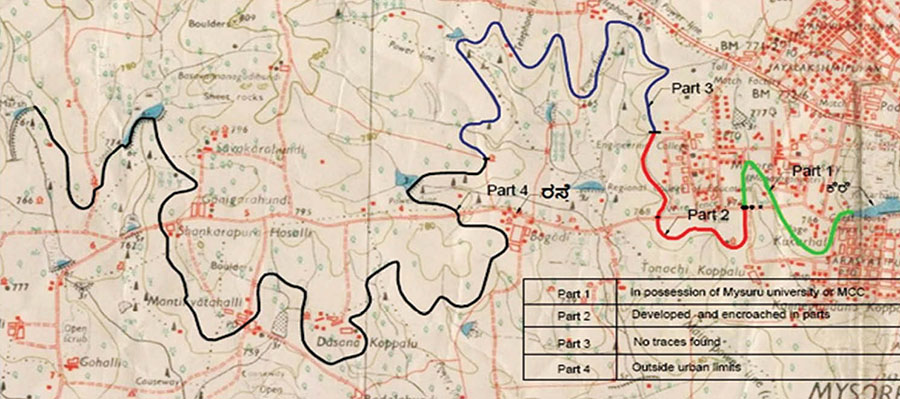
Water to Southern Mysuru
Kukkarahalli Lake, which was constructed to supply water to southern parts of city and for irrigation purposes, used to receive most of its inflow from several other basins spread over the western part of the Lake. This was made possible by a feeder Canal that was cut to intercept many streams draining suburban land in western parts of the city, encompassing villages like Bogadi, Hinkal, Dasanakoppal, Ganagarahundi and others.
It is now history that this 20-km-long Canal (built in 1861 and named after Krishnacharya Purnaiah (1746 -1812), the first Dewan of Mysore) used to divert water from streams to Kukkarahalli Lake. Otherwise, in the absence of the Canal, water would have fed five to six downstream tanks.
Study of topo-sheets
Initially, Kukkarahalli Lake supplied water throughout the year to industries and residential areas in southern part of city. Therefore, there was a need to bring a large amount of water to the tank at that time. However, that situation is not present now. There is only a need to keep the tank alive and pollution-free.
The report mentions that in recent years, a large amount of water was not being obtained from the Lake’s catchment. Hence, it is necessary to utilise the services of Dewan Purnaiah Canal.
In this context, the preliminary report on restoration of this Purnaiah feeder Canal was prepared based on a study of topo-sheets of Survey of India (1970), Google Earth satellite images and a reconnaissance survey on-site along the Canal alignment.
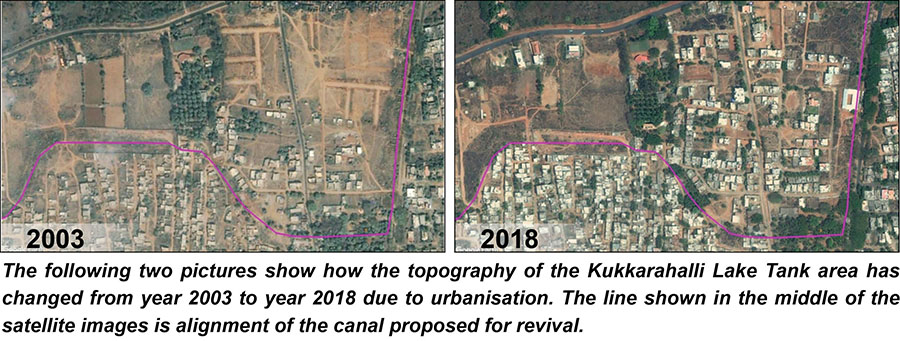
Accessible for rejuvenation
Based on the site inspection, the 20-km feeder Canal (Purnaiah Canal) has been identified in four parts: the last part of the alignment that is mostly in good condition and easy to revive (about 3 km); partly encroached but accessible for rejuvenation (about 2.5 km); almost completely encroached (not recognisable on the ground due to urban development); and a stretch not yet fully accessed for urban development (visible on the ground and reclaimable).
The report emphasised in 2018 that District Administration could retain the last stretch mentioned above “if action is initiated immediately.”
Regarding catchment and water volume, the report covers the section of Canal that runs west of Sri Jayachamarajendra College of Engineering (SJCE), past Bogadi Road, Bisilu Maramma Temple and up to AIISH.
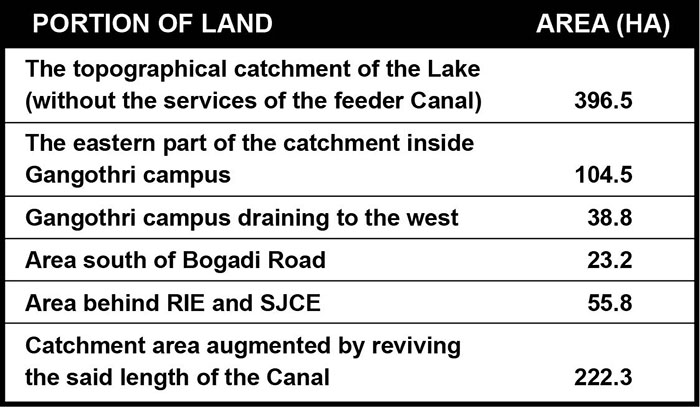
Catchment area increase
The length of this section is 2,200 m and the catchment areas that this section drains are identified. The extent of land drained by different parts of this stretch suggests that when this portion of urban area of the Canal is rehabilitated, the catchment area of the tank will increase by about 60 percent and the amount of rainwater reaching Kukkarahalli Lake is expected to increase by about 50 percent. [See table]
Since a significant length of the tail-end part of the feeder Canal lies on land owned by Mysore University or the State Government, rejuvenation work can be easily undertaken.
The report also mentions that the Canal can be easily restored by desilting the portion downstream of AIISH. Since the Canal has been blocked in many places along the rest of its length, some challenges may arise during revival work. It is a fact that no trace of Canal is found in the area west of SJCE and Regional Institute of Education (RIE).
Diverting water to Canal
Therefore, a new stormwater drain of about 700 m would be required to divert water into the Canal. Since the entire area of Canal along the alignment between RIE and AIISH (chainage 1,010 m to 1,280 m) has been encroached upon to the extent that no trace of it can be seen, eviction may have to be considered in some areas of Janata Nagar 1st, 2nd and 3rd Cross Roads.
Prof. Putty stated that caution must be exercised when dealing with the part of Canal (from 1,680 m to 1,900 m) as it is within Bisilu Maramma Temple premises. Additionally, between the temple and AIISH, the Devirammanni Deaf and Dumb Orphanage has been constructed in the middle of the channel section.
The report highlights that the project involves reconstructing the Canal to a length of about 2,200 m, with a depth of 8 feet and a width of 20 feet. There is a scope to reclaim and develop the entire width of the original Purnaiah Canal. Also, there is a need for desilting the Canal on Mysore University land.
It may be recalled that NIE faculty members, under the leadership of Prof. Putty, U.N. Ravikumar and Dr. Manjunath, have conducted numerous studies on hydrological, environmental and quality aspects of the Lakes of Mysuru city and have developed innovative solutions.
Hope for Kukkarahalli Lake if there is political will
It is possible to restore Kukkarahalli Lake to its original state with Purnaiah Canal (also known as Raja Kaluve) being tracked even at its most invisible part and encroached lengths, according to Prof. G.L. Shekar’s article. Only political will is required. Also, a little co-operation from the land-losers (canal area losers). But the Government must financially compensate them wherever re-location or dislodging is required.
According to MGP Founding President Dr. Bhamy V. Shenoy, some of the land and canal area of Purnaiah Canal were found encroached and converted either as agricultural land or allotted as sites, during the enquiry conducted by the then Deputy Commissioner (DC) T.M. Vijay Bhaskar. This is mentioned in the famous but now dead 29-year-old Report as ‘T.M. Vijay Bhaskar Report’ which was resurrected by SOM in its issue dated 24.7.2024.
This Lake, of course, is not meant to supply water to local residents and industries as it was intended when it was built in 1861. But it must be saved as a water body, lung space and as a centre of biodiversity in the heart of the city.—Editor
Realistic suggestions to save Kukkarahalli Lake
In late 19th century and early 20th century, there was a need to bring a large amount of water to Kukkarahalli Lake. But NOW that large amount of water is not needed.
Therefore, suffice it is NOW to utilise the water that could be obtained by reviving the Dewan Purnaiah Canal, as suggested by Prof. R. Yadupati Putty Report. Chief Minister Siddaramaiah should make up his mind. —Editor



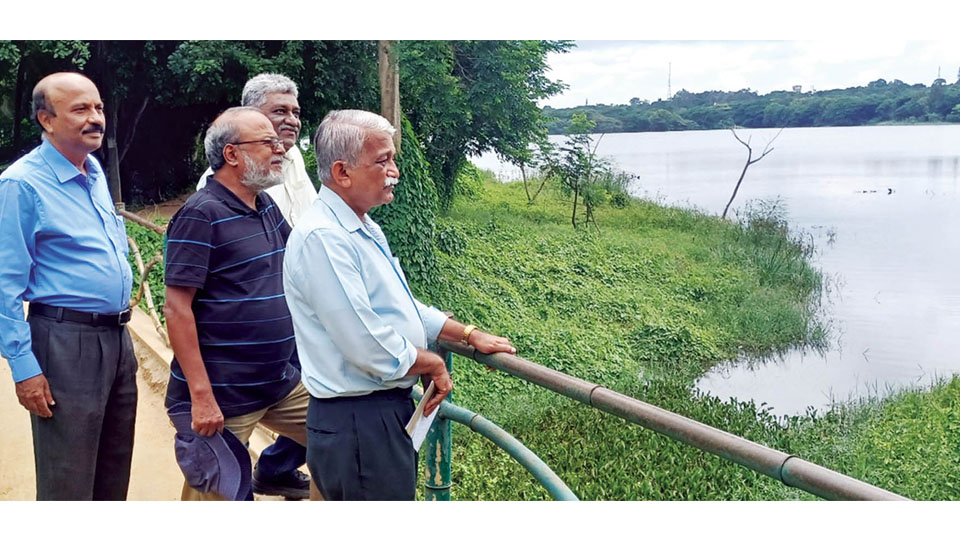
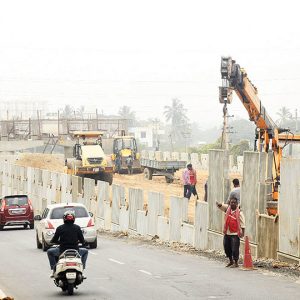
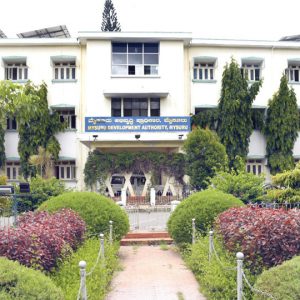

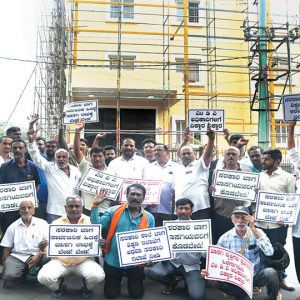
Recent Comments